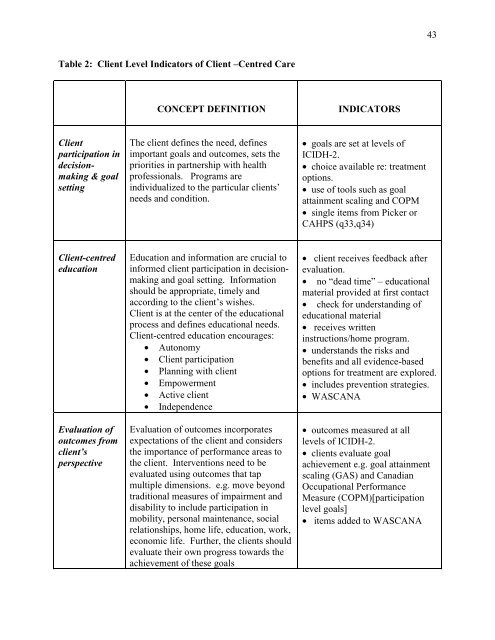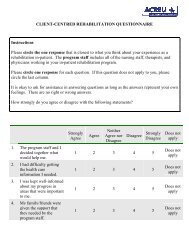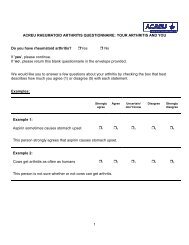Client-Centred Rehabilitation - Arthritis Community Research ...
Client-Centred Rehabilitation - Arthritis Community Research ...
Client-Centred Rehabilitation - Arthritis Community Research ...
Create successful ePaper yourself
Turn your PDF publications into a flip-book with our unique Google optimized e-Paper software.
43<br />
Table 2: <strong>Client</strong> Level Indicators of <strong>Client</strong> –<strong>Centred</strong> Care<br />
CONCEPT DEFINITION<br />
INDICATORS<br />
<strong>Client</strong><br />
participation in<br />
decisionmaking<br />
& goal<br />
setting<br />
The client defines the need, defines<br />
important goals and outcomes, sets the<br />
priorities in partnership with health<br />
professionals. Programs are<br />
individualized to the particular clients’<br />
needs and condition.<br />
• goals are set at levels of<br />
ICIDH-2.<br />
• choice available re: treatment<br />
options.<br />
• use of tools such as goal<br />
attainment scaling and COPM<br />
• single items from Picker or<br />
CAHPS (q33,q34)<br />
<strong>Client</strong>-centred<br />
education<br />
Evaluation of<br />
outcomes from<br />
client’s<br />
perspective<br />
Education and information are crucial to<br />
informed client participation in decisionmaking<br />
and goal setting. Information<br />
should be appropriate, timely and<br />
according to the client’s wishes.<br />
<strong>Client</strong> is at the center of the educational<br />
process and defines educational needs.<br />
<strong>Client</strong>-centred education encourages:<br />
• Autonomy<br />
• <strong>Client</strong> participation<br />
• Planning with client<br />
• Empowerment<br />
• Active client<br />
• Independence<br />
Evaluation of outcomes incorporates<br />
expectations of the client and considers<br />
the importance of performance areas to<br />
the client. Interventions need to be<br />
evaluated using outcomes that tap<br />
multiple dimensions. e.g. move beyond<br />
traditional measures of impairment and<br />
disability to include participation in<br />
mobility, personal maintenance, social<br />
relationships, home life, education, work,<br />
economic life. Further, the clients should<br />
evaluate their own progress towards the<br />
achievement of these goals<br />
• client receives feedback after<br />
evaluation.<br />
• no “dead time” – educational<br />
material provided at first contact<br />
• check for understanding of<br />
educational material<br />
• receives written<br />
instructions/home program.<br />
• understands the risks and<br />
benefits and all evidence-based<br />
options for treatment are explored.<br />
• includes prevention strategies.<br />
• WASCANA<br />
• outcomes measured at all<br />
levels of ICIDH-2.<br />
• clients evaluate goal<br />
achievement e.g. goal attainment<br />
scaling (GAS) and Canadian<br />
Occupational Performance<br />
Measure (COPM)[participation<br />
level goals]<br />
• items added to WASCANA








